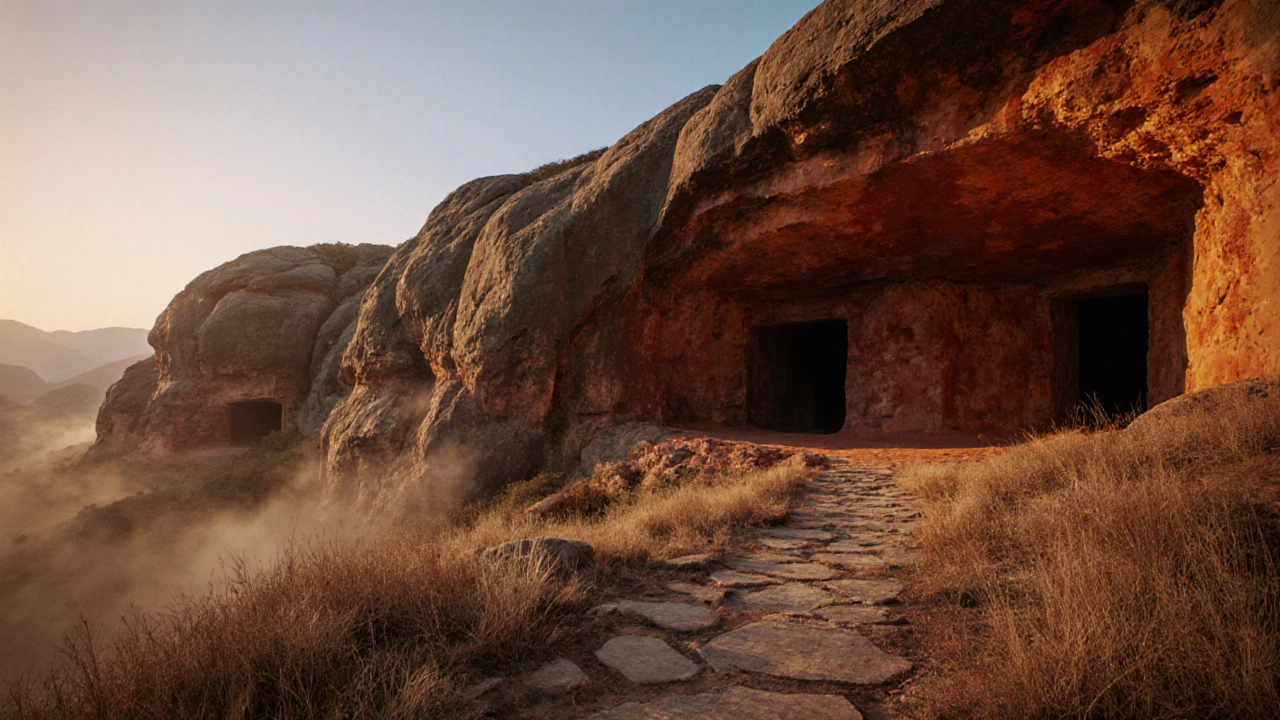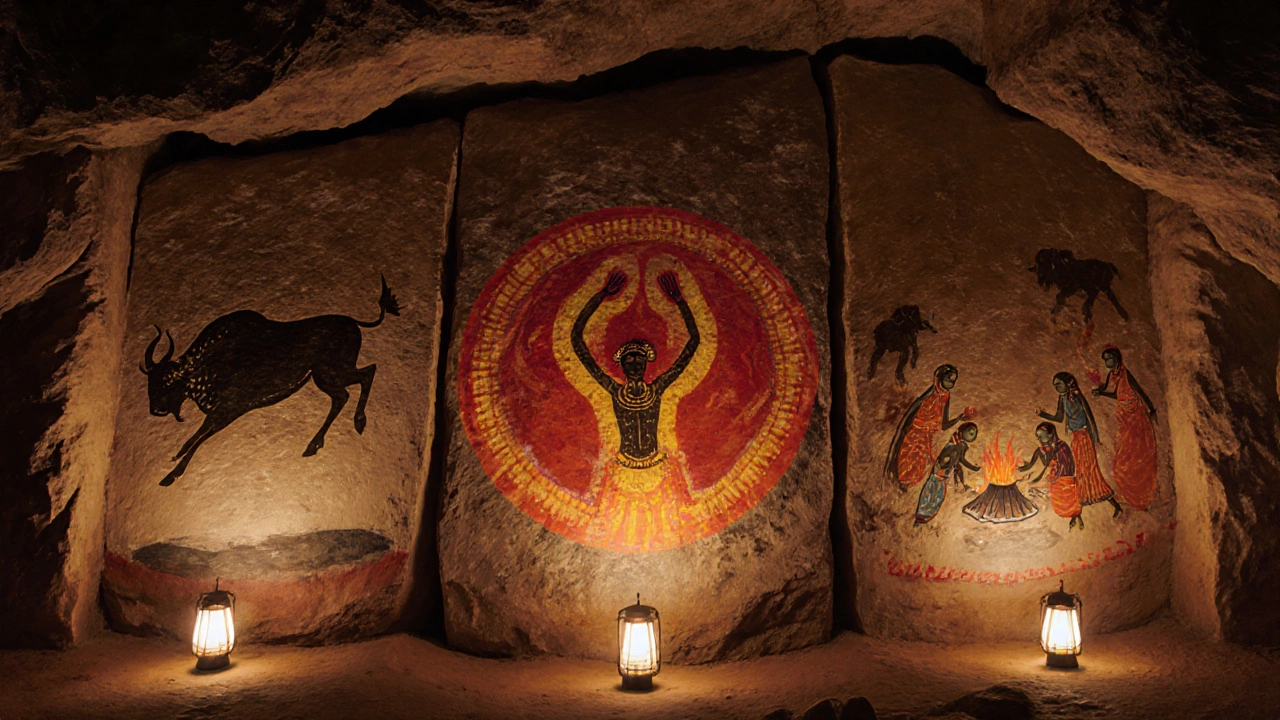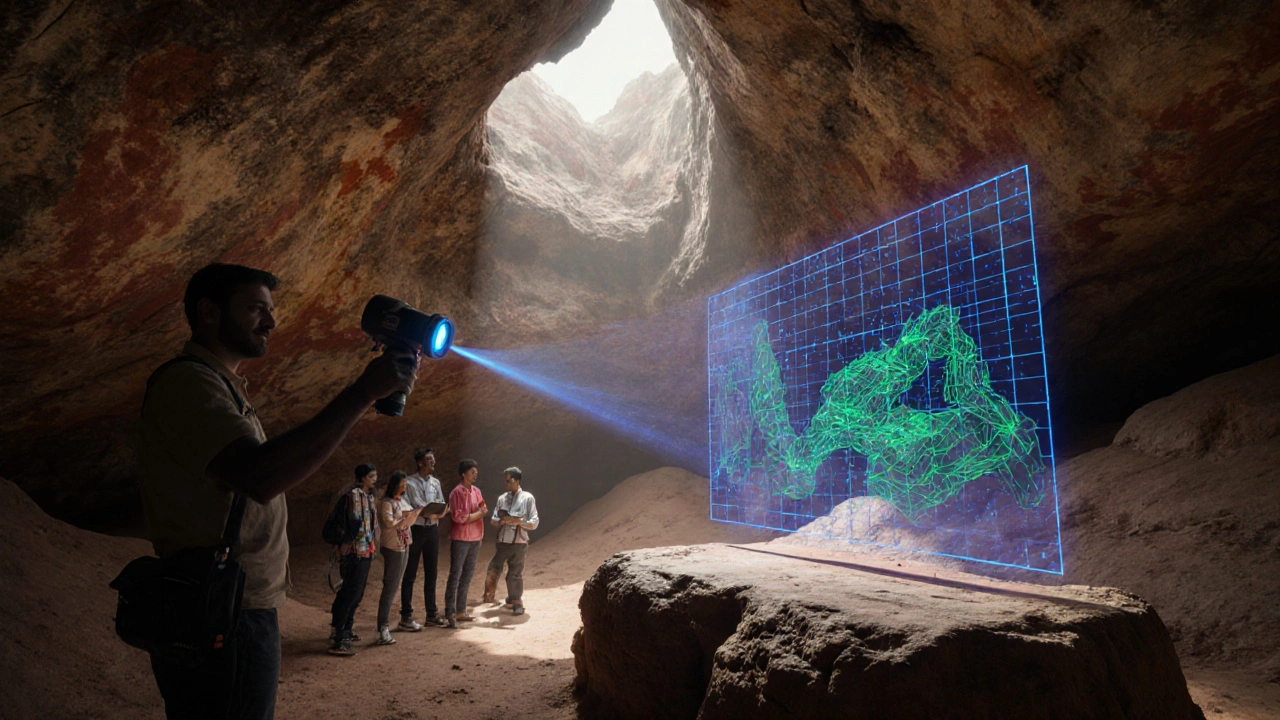India's Oldest Archaeological Site: The Most Ancient Place Revealed

- Oct, 8 2025
- 0 Comments
- Aaron Blackwood
Ancient India Timeline Explorer
Explore the oldest archaeological sites in India and see how they compare in terms of age and cultural significance.
Bhimbetka Rock Shelters
~100,000 years BP
Lower Paleolithic
Oldest known inhabited place in India with extensive rock art
View DetailsDholavira
~5,000 years BP
Harappan Civilization
Advanced water conservation system of the Indus Valley Civilization
View DetailsMehrgarh
~7,000 years BP
Neolithic Period
Earliest Neolithic site in South Asia with farming evidence
View DetailsSite Comparison Chart
| Site | Earliest Occupation (Years BP) | Primary Cultural Phase | UNESCO Status | Notable Feature |
|---|---|---|---|---|
| Bhimbetka Rock Shelters | ~100,000 | Lower Paleolithic | World Heritage (2003) | Extensive prehistoric rock art |
| Dholavira | ~5,000 | Harappan (Indus Valley) | World Heritage (2021) | Advanced water-conservation system |
| Mehrgarh | ~7,000 | Neolithic | Not yet listed | Earliest Neolithic site in South Asia |
Dating Methods Used at Bhimbetka
Optically Stimulated Luminescence (OSL)
Dates sediment layers by measuring light emission from sand grains when exposed to light, indicating when caves were last exposed to sunlight.
RadioCarbon Dating
Measures decay of carbon-14 in organic materials like charcoal from hearths to determine ages up to 30,000 years.
Rock Art Analysis
Pigment composition compared to known prehistoric palettes suggests a minimum age of 30,000 years with some evidence pointing to even older origins.
When you hear "ancient India," you probably picture the Indus Valley or grand temples. The spot that actually pushes human history back the farthest in the subcontinent is Bhimbetka Rock Shelters - a sprawling complex of caves and rock art dated up to 100,000 years old. This UNESCO World Heritage site in central Madhya Pradesh proves people were carving, painting, and living here long before any city ever appeared.
Quick Takeaways
- Bhimbetka is the oldest known inhabited place in India, with evidence from the Lower Paleolithic.
- The site contains over 750 rock panels showing hunting scenes, dancing, and daily life.
- It was declared a UNESCO World Heritage Site in 2003, guaranteeing protection and global recognition.
- Visiting Bhimbetka is easy: the nearest airport is in Bhopal, and local buses run daily from the town of Satna.
- Related ancient sites to explore: Dholavira (Harappan), Mehrgarh (Neolithic), Ajanta Caves (Buddhist), Sanchi Stupa (Mauryan).
Why Bhimbetka Beats All Other Claims
Archaeologists date the earliest layers of Bhimbetka to the Acheulean tool culture, around 100,000 years ago. That makes it older than any Harappan settlement, older than the earliest Buddhist stupas, and older than the coined term "civilization" itself. The depth of the site’s stratigraphy - more than 20 occupational layers - lets researchers track human activity from the Lower Paleolithic right through the historic period.
The Science Behind the Dating
Scientists use a mix of methods to pin down Bhimbetka’s age. Optically Stimulated Luminescence (OSL) dating of sand grains shows when the caves were last exposed to sunlight, while radiocarbon dating of charcoal from hearths gives ages up to 30,000 years for later layers. The oldest rock paintings, however, are dated by comparing pigment composition to known prehistoric palettes, suggesting a minimum age of 30,000 years, with some scholars arguing for even older origins based on stylistic analysis.

What the Paintings Actually Show
The panels are organized into three main themes:
- Hunting and Gathering - Silhouettes of antelopes, bison, and wild boar, often portrayed mid‑leap, reveal early hunting techniques.
- Ritual and Dance - Circular figures with raised arms likely depict communal celebrations or trance dances.
- Everyday Life - Scenes of women grinding grain, children playing, and families around fire give a vivid snapshot of prehistoric social structure.
These images aren’t just art; they’re a visual record of how early humans adapted to their environment.
How Bhimbetka Compares to Other Ancient Indian Sites
| Site | Earliest Occupation (Years BP) | Primary Cultural Phase | UNESCO Status | Notable Feature |
|---|---|---|---|---|
| Bhimbetka Rock Shelters | ~100,000 | Lower Paleolithic | World Heritage (2003) | Extensive prehistoric rock art |
| Dholavira | ~5,000 | Harappan (Indus Valley) | World Heritage (2021) | Advanced water‑conservation system |
| Mehrgarh | Neolithic | World Heritage (pending) | Early farming and metallurgy | |
| Ajanta Caves | ~2,000 | Mahāyāna Buddhist | World Heritage (1983) | Murals depicting Jataka tales |
| Sanchi Stupa | ~2,200 | Mauryan/Śramaṇa | World Heritage (1989) | Great Stupa with railings and toranas |
The table shows why Bhimbetka outranks every other Indian locale when it comes to sheer antiquity. Even sites like Mehrgarh, famous for early agriculture, are still thousands of years younger.
Planning a Visit: Practical Tips
Getting there is surprisingly straightforward. Fly into Bhopal’s Raja Bhoj Airport, then take a 150‑km road trip to the town of Bhimbetka. Local taxis or state‑run buses drop you off at the visitor’s center, where a short briefing explains the site’s layout. Most of the shelters are open year‑round, but the best window is from October to March when daylight is ample and humidity low.
- Timing: Arrive early (8am) to avoid crowds and catch the sunrise lighting on the panels.
- Guides: Certified guides cost around ₹300 per hour and can point out subtle details in the paintings that casual visitors miss.
- What to bring: Light trekking shoes, a water bottle, sunscreen, and a camera with a zoom lens (flash is prohibited inside the caves).
- Nearby attractions: The Satna Museum houses smaller rock‑art replicas, while the nearby Pachmarhi hills offer trekking routes with panoramic views of the shelter valley.

Preservation Challenges and Ongoing Research
Even with UNESCO protection, Bhimbetka faces threats. Seasonal monsoon runoff can erode the rock surfaces, and unregulated tourism sometimes leads to graffiti. The Archaeological Survey of India (ASI) has launched a “Digital Capture” project, using 3‑D laser scanning to create a virtual replica of every panel. Researchers worldwide can now study the art without physically touching the caves.
Current excavations are focusing on deeper sediment layers, hoping to uncover even older evidence of human activity. If new findings push the date back further, Bhimbetka could rewrite the timeline of human settlement across South Asia.
Related Ancient Destinations Worth Adding to Your Itinerary
If you’re fascinated by Bhimbetka, consider these complementary stops:
- Dholavira - Explore the sophisticated water‑storage tanks of the Harappan civilization; a stark contrast to prehistoric cave life.
- Mehrgarh - See the transition from hunter‑gatherer to farmer, just a few thousand years after Bhimbetka’s earliest layers.
- Ajanta Caves - Marvel at Buddhist frescoes that, while much later, demonstrate India’s continuous legacy of rock art.
- Sanchi Stupa - Experience the grandeur of Mauryan architecture, representing the next cultural leap after the prehistoric era.
Each site adds a chapter to the story that began in the dark, windy corridors of Bhimbetka.
Frequently Asked Questions
Why is Bhimbetka considered the most ancient place in India?
Archaeological layers at Bhimbetka have been dated to about 100,000 years ago, making it older than any known urban settlement, religious monument, or recorded civilization in the subcontinent.
Can I photograph the rock paintings?
Photography is allowed, but flash is prohibited to protect the pigments. Using a zoom lens and natural light yields the best results.
What is the best time of year to visit?
October through March offers clear skies and moderate temperatures, ideal for exploring both indoor shelters and the surrounding landscape.
Are there any guided tours available?
Yes, the ASI provides certified guides at the entrance. Private guides can also be booked in nearby Satna for a deeper dive into the symbolism of the art.
How does Bhimbetka compare to the Indus Valley sites?
While Harappan cities like Mohenjo‑daro and Dholavira are remarkable for urban planning, they appear around 5,000 years ago-far later than Bhimbetka’s Lower Paleolithic origins.